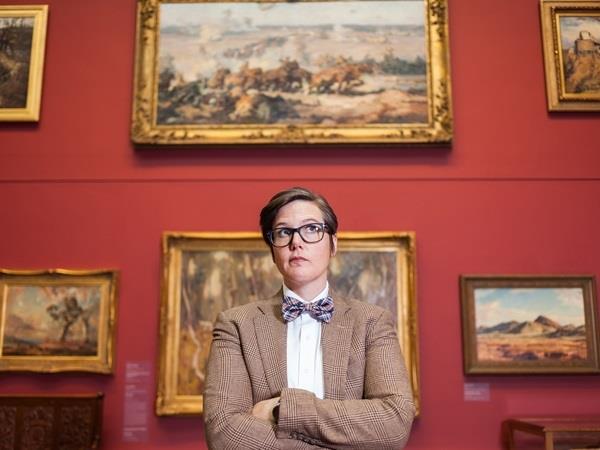In Hannah Gadby’s OZ, the comedian and art scholar travelled across the continent in search of Australiaʼs identity through the history of art; Image: supplied.
The ABC television archives date back to 1956, and the radio and still image collections are even older beginning in 1932.
With such an expansive collection, many filmmakers, curators and even artists have approached the ABC to use footage and programs in their own creative practice.
We’ve compiled a diversity of approaches used to create new work and provide context for audience.
1. Examine our mortality
In her O-bit video series, artist Layla Vardo created three works that examine the ageing process of television presenters.
One of the short video works features ABC reporter Richard Morecroft and contains 4:27 minutes of his intake of breath before reporting each obituary. The visible process of ageing is witnessed by the viewer, also reminding them of their own mortality.
2. Piece together a biography
After uncovering a vast personal archive of material belonging to the friend of Australian performer Wendy Saddington, the Canberra Museum and Gallery curated an exhibition to explore Australian popular music history through the lens of Saddington’s career.
‘I had a lot of fun with this request from the Canberra Museum and Gallery late last year,’ said Juliet Stuart-Smith, Sales Executive, Library Sales- Programs.
‘One of the organisers was a friend of Wendy Saddington who had some old VHS tapes that he had recorded off the television and I was able to match the footage that he had with the actual program in our archive. We were able to supply them with much better quality material to include in their exhibition.’
3. Help understand an issue
If you are working on a project that involves current affairs or political themes, chances are the ABC will have some audio and video coverage you can use in interesting ways.
In the short film by collaborative production company HitRecord for example, the large archive of news audio was utilised to detail the Port Arthur massacre in Australia and the government response. HitRecord then overlayed these recordings on an animated depiction of events.
4. Enhance public discussion
At the 2016 Mardi Gras in Sydney, footage from the ABC program Being Me was included in the multidisciplinary exhibition HUMAN 3.0.
The included footage tells the story of eleven-year-old Isabelle and her experience of being transgender. The episode was exhibited alongside photography depicting transgender adults and children by Nicholas Contrera, Extra Ordinary – Trans Life, and Sarah Wong’s photography series, Inside Out: Portraits of Cross-Gender Children.
5. Explore commissions and inspire ideas
Artist Robyn Backen also adopted a montage technique to create the work Yours mine ours: 50 years of ABC TV. The visual projection and sound work explores how the telephone is used in Australian drama and explores the sound and action of communication technology as a form of poetry.
Exhibited at Penrith Regional Gallery in 2006, the ABC commissioned Backen for the work and provided the fragments that she used to create the one-sided phone conversations that flash momentarily across the screen.
Later Backen also created It’s me… I’m here… where’re you? from footage held in the ABC archives.

Robyn Backen 2006 yours mine ours 50 years of abc TV; Image: robynbacken.com.
6. Look back at Australian art history
For the retrospective of Frank Norton, the Fremantle Arts Centre approached the ABC to use particular news interview footage with the Royal Australian Navy painter and illustrator from the 1970s.
‘Curators can always ask us to find more information from our archives. People usually come to us after having found things online or references to material, but this doesn’t always cover the full breadth of what we can provide to people,’ said Stuart-Smith.
7. Engage an audience
In Michael Gow play Once in Royal David’s City (2014) at Belvoir Street Theatre, an episode from the ABC science program Why is it so? was incorporated in part of the set design.
In a similar vein, Melville Theatre Company’s also accessed the ABC archive for their production of Don Parties On. ABC supplied coverage of the 2010 election night tally to feature as part of the backdrop for the production.
8. Tell a history
In partnership with James Cook University and the City Council, the Museum of Tropical Queensland curated an exhibition to commemorate the 150 year history of Townsville.
Townsville Turns 150 includes news coverage of events to explore the city’s development and character, including a news eyewitness report from the ABC archives on the Japanese air raid in Townsville in 1942.
9. Find reference material
Collections are also regularly accessed as research for upcoming productions. Hours of reference material was provided for Keating! The Musical to assist with the portrayal of Paul Keating.
Northern Pictures approached the ABC in 2014 with a request to locate as much about Brett Whiteley as possible from the ABC’s Radio and Television archive to include in their landmark feature documentary WHITELEY.
Over a two year period the ABC researches found and then supplied rich ABC Radio/TV Arts and News content.
Long-form Radio interviews from the early 80s and 90s were supplied, including the GTK (Get to Know) stories documenting Whiteley’s exhibitions, notably the Alchemy exhibition at the Bonython Gallery in 1973. The GTK programs documented much of the music and arts life of this period. This footage wasn’t only used for reference material but also formed part of the documentary itself.
To find out more about the collection held by ABC archives and also its contemporary arts programming visit https://www.abccommercial.com/librarysales/
Add your details to the ABC contacts list to receive updates on the latest activities here https://confirmsubscription.com/h/d/92EC0499077DED87





